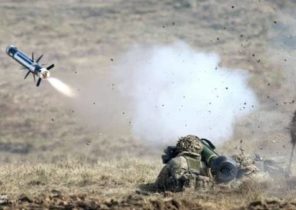In the Caucasus, is gaining momentum the forgotten war, which armed with increasingly advanced drones for reconnaissance and attacking. The disturbing consequences of this war can go far beyond this little corner of Eurasia.
After the collapse of the Soviet Union, a conflict broke out between the newly independent Armenia and Azerbaijan over Nagorno-Karabakh. This Armenian-populated enclave under the law is part of Azerbaijan. When Armenia during the fighting in 1994 he gained control over the territory, with the mediation of Russia, an agreement was signed ceasefire. Nagorno-Karabakh declared itself an independent state with the name of Artsakh, but was unable to gain international recognition, and many still consider it part of Azerbaijan. The conflict between Azerbaijan on the one hand and Artsakh with his patron of Armenia, on the other quietly smolders to this day.
In 2016 the situation escalated, and started a real war in which both sides killed tens, maybe hundreds of people. Since then, clashes erupt periodically. Escalation for 2016 was notable for the fact that the conflict was used a new type of weapon. It was a UAV “Harop”, or drone bombers, which the Azerbaijanis have put Israel. According to available information, “Haropa” destroyed a variety of targets, including artillery, air defense systems and the bus with the Armenian armed forces.
UAV “Harop” was supplied by IAI. The competitor Aeronautics began to advertise its own products, and it turned into a kind of black Comedy. In 2017, the team of specialists arrived in Azerbaijan to enter into a contract to supply drones kamikaze “Orbiter 1K”, and the local party asked them to strike at enemy positions. When the Israeli operators of the drones refused, “a senior company representatives took matters into their own hands and have started to send the drones, but in the end the order didn’t hit,” said at the time, “Jerusalem Post” (the Jerusalem Post).
For this outrage, the Israeli authorities imposed a ban on Aeronautics for a period of two years. In 2019, the restraining order expired, and the company immediately announced the supply to Azerbaijan drones for a total amount of 13 million dollars. In the future, the Azerbaijanis themselves are planning to engage in licensed production of “Orbiter”, which they called “Zarb”. In 2019 Azerbaijan also purchased in Israel party drones “sky striker”.
Local production of drones is also gaining momentum. In 2018, one Azerbaijani company has announced that it is working on the creation of three drones-kamikaze different sizes. One of them will get a five-kilogram warhead and can in three hours to fly, looking for targets. Another company is developing a UAV Bat (Bat), which can return to base, if the goal is to defeat not detected.
The opposite side is also not standing still. Armenia is engaged in the manufacture of drones since 2011, when she demonstrated a basic model reconnaissance drone “Krunk” (crane). To replace it have been a new model of “Krunk-9” and “Krunk-11”.
In 2018 Armenia has announced the purchase of military drones in Artsakh. This small state, obviously, there is existing capacity for the production of drones, because in the past month, the defense Ministry announced the successful test of a new combat drone, mass production will begin in a few months. The Ministry even published a video which shows how drone bombers hit the target. The war Department stated that the sample “technical characteristics is not inferior to similar devices, the development of which involved leading the country.”
In 2019 Armenian TV channel “Shant news” showed a whole collection of military drones.
Drones are ideal for conflicts of this type. They are cheap, very accurate, and can be used without risk to the pilot. Plus he can always disown. Even if the drone was shot down, the operator can claim that it has any relation to it. So did the United States when in the 1960-ies and later the China was shot down in his reconnaissance UAV sky “Firby”. Reports of downed drones come regularly. The last time was in April, when the troops of Artsakh’s downed Azerbaijani Orbiter.
The fact that these small and distant countries launch into the sky the tiny aircraft loaded with explosives and strike each other, does not cause much concern. But the UAV will be applied not only there. And drones are far from primitive.
“Many former Soviet republics after the collapse of the Soviet Union inherited the scientific and technical knowledge, the secrets of military production and industrial base, — said analyst of the Washington-based Center for a new American security (Center for a New American Security) Samuel Bendett (Samuel Bendett). Over the last decade we see that the monopoly on the production and use of drones disappears. If this was done before the very few countries such as the US, Britain, Israel, Iran and China, now there are dozens of countries”.
Particularly illustrative example — Ukraine. During the conflict with Russia she had to quickly develop their own model of UAV. University groups, engineers, Amateurs and servicemen have joined forces to troops as quickly as possible got effective samples. The results were impressive. When the United States in 2016, Ukraine has put UAV RQ-11 “Raven”, they quickly became prey to Russian jamming devices. Ukrainians are on their drones learned responses.
The us military also purchase of commercial drones “Skidoo”, and this suggests that the commercial sector can catch up with the military-industrial complex, while now the lag is four to six years. New drone Artsakh too, may not be worse than those of the samples that are offered by other countries.
“This trend is accelerating. Already, Ukraine, Estonia, Belarus, Armenia, Azerbaijan and Kazakhstan, or produce and use, or announced its intention to establish its own production of unmanned systems,” said Bendett.
While some small countries today produce their own UAVs, a NATO member, for example, Britain and Germany, do not have armed combat drones. The us military is loitering munitions “of Switchblade”, but there is no effective defense against enemy drones-bombers, with whom they may well encounter.
“The UAV is a cheap means of increasing combat effectiveness. A small army such as in the Caucasus countries, can significantly increase its combat capability through the acquisition of unmanned system,” said Bendett.
Companies such as Azerbaijani “Isdynamic” actively trying to export drones. The more common they get, the easier it is for countries to acquire such weapons. Drone war in the Caucasus may soon become a war of drones in your backyard.






